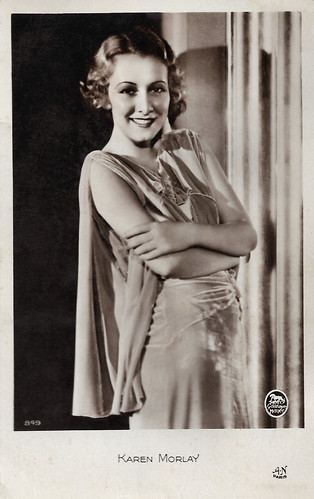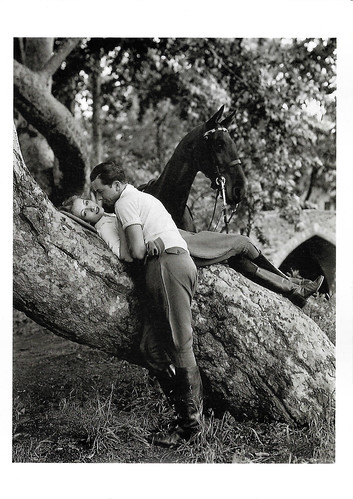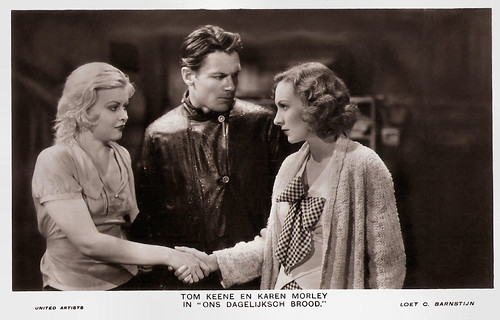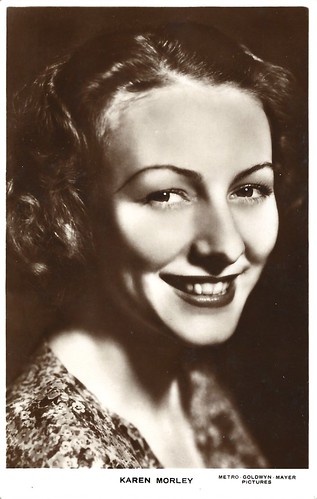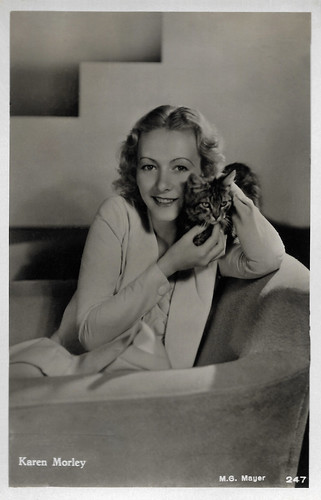Freiherr (Baron) Wolff von Gudenberg (1890-1961 or 1964) was a photographer who was noted and fashionable in the 1920s and 1930s in Berlin. Wolff von Gudenberg is the name of an old Hessian noble family that was raised to the rank of baron in 1873. He photographed actors like Marlene Dietrich and Fritzi Massary, dancers like Marianne Winkelstern and La Jana, and international celebrities such as Josephine Baker and Anna May Wong. His photos appeared in magazines such as Die Dame, newspapers like Berliner Illustrirte Zeitung (BIZ), and on countless postcards by Ross Verlag and other publishers. To commemorate this forgotten photographer, we selected 20 postcards with his portraits. Marlene Pilaete added three special cigarette cards of Marlene Dietrich to the post.

Dutch postcard by JSA, no. 230. Photo: Frhr. W. von Gudenberg. Collection: Marlene Pilaete.
Marlene Dietrich (1901-1992) was the first German actress who succeeded in Hollywood. Throughout her long career, she constantly reinvented herself. In 1920s Berlin, she started as a cabaret singer, chorus girl, and film actress. In the 1930s, she became a Hollywood star, then a World War II frontline entertainer, and finally, she was an international stage show performer from the 1950s till the 1970s. Now we remember her as one of the icons of the 20th century.

Dutch postcard by JSA, no. 232. Photo: Freiherr Wolff von Gudenberg.
The Austrian actor
Willi Forst (1903-1980) was a darling of the German-speaking public. He was also one of the most significant directors, producers, writers and stars of the
Wiener Filme, the light Viennese musical comedies of the 1930s.
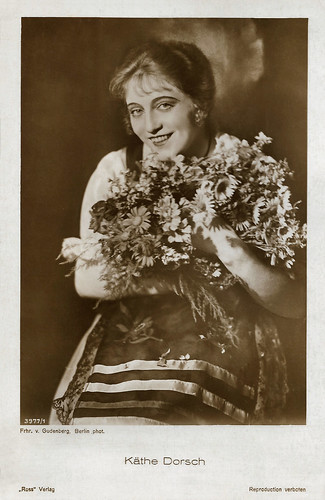
German postcard by Ross Verlag, no. 3977/1, 1928-1929. Photo: Frhr. v. Gudenberg, Berlin.
German actress
Käthe Dorsch (1890-1957) was a famous stage actress in Vienna and Berlin. She also made several silent and sound films.
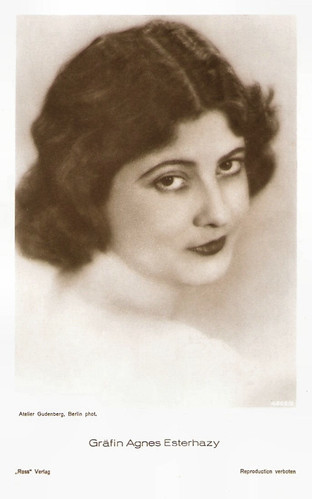
German postcard by Ross Verlag, no. 4869/2, 1929-1930. Photo: Atelier Gudenberg, Berlin.
Hungarian film actress (Gräfin)
Agnes Esterhazy (1891-1956) worked mainly in the silent cinema of Austria and Germany. The countess appeared in more than 30 films between 1920 and 1943.

German postcard by Ross Verlag, no. 5167/1, 1930-1931. Photo: Atelier Gudenberg, Berlin.
Anna May Wong (1905-1961) was the first Chinese American movie star and the first Asian American actress to gain international recognition. Frustrated by the stereotypical supporting roles she reluctantly played in Hollywood, Wong left for Europe, where she starred in such classics as
Piccadilly (1929).

German postcard by Ross Verlag, no. 5230/1, 1930-1931. Photo: Frhr. von Gudenberg, Berlin.
Elisabeth Bergner in
Der Geiger von Florenz (Paul Czinner, 1926).
The profoundly sensitive acting of Austrian-British actress
Elisabeth Bergner (1897-1986) influenced the German cinema of the 1920s and 1930s. She specialised in the bisexual type that she portrayed in
Der Geiger von Florenz and other film and stage roles. Nazism forced her to go into exile, but she worked successfully in the West End and on Broadway.

German postcard by Ross Verlag, no. 5304/1, 1930-1931. Photo: Frhr. von Gudenberg, Berlin.
French actor and singer
Albert Préjean (1894-1979) was a former WWI flying ace. He is best known for playing heroes in the silent films of René Clair, and for playing George Simenon's detective Maigret.

German postcard by Verlag Piek, Postdam, no. 855. Photo: Frhr. von Gudenberg.
Max Hansen,
Alfred Jerger and
Siegfried Arno in the play 'Die drei Musketiere' (The Three Musketeers, 1929) at the Grosse Schauspielhaus.

German postcard by Ross Verlag, no. 5555/1, 1930-1931. Photo: Freiherr von Gudenberg, Berlin.
Danish cabaret artist, actor, comedian, and singer
Max Hansen (1897-1961) was known as 'The Little Caruso'. During the 1920s, he was one of the most popular stars in Berlin.

German postcard by Ross Verlag, no. 5844/1, 1930-1931. Photo: Frhr. von Gudenberg, Berlin.
German singer/actress
Charlotte Ander (1902-1969) was a star in the silent era before making the transition to sound. The Nazis broke her successful career because she was not of 'pure blood'.

German postcard by Ross Verlag, no. 6760/1, 1931-1932. Photo: Ufa / Frhr. von Gudenberg.
Trude Marlen in
Spiel mit dem Feuer/Playing with Fire (Ralph Arthur Roberts, 1934).
Trude Marlen (1912-2005), was a curly-locked Austrian leading lady of the 1930s. From 1933 until the 1940s, she made mostly light entertainment films as a Ufa star, in which Willi Forst was often her partner. The Ufa traded her as the German answer to Jean Harlow, but for the most part, she was the Viennese equivalent of the 'girl next door', engaging and uncomplicated.

German postcard by Ross Verlag, no. 6799/1, 1931-1932. Photo: Freiherr v. Gudenberg.
Hungarian-born singer and actress
Márta Eggerth or
Martha Eggerth (1912-2013) maintained a global career for over 70 years. She was the popular and talented star of 30 German and Austrian films of the 1930s.

German postcard by Ross Verlag, no. 7049/1, 1932-1933. Photo: Frhr. von Gudenberg Phot.
Hungarian-born
Gitta Alpár (1903-1991) was a Jewish actress, opera and operetta singer, and dancer, whose successful career in Germany was broken by the Nazis.

German postcard by Ross Verlag, no. 7762/2, 1932-1933. Photo: Frhr. von Gudenberg.
Smart German actor
Gustav Fröhlich (1902-1987) played Freder Fredersen in the classic
Metropolis (1927) and became a popular star in light comedies. After the war, he tried to escape from the standard role of a charming gentleman with the part of a doomed painter in
Die Sünderin (1951), but the effort went down into a scandal.

German Postcard by Ross Verlag, no. 8294/12, 1933-1934. Photo: Frhr. von Gudenberg / Ufa.
Jovial, pleasantly plump
Hans Albers (1891-1960) was a superstar of German cinema between 1930 and 1945. He was also one of the most popular German singers of the twentieth century. His song
Auf der Reeperbahn nachts um halb eins (On the Reeperbahn at half past midnight) is the unofficial anthem of Hamburg’s neighbourhood of St. Pauli, famous for its brothels, music and nightclubs.
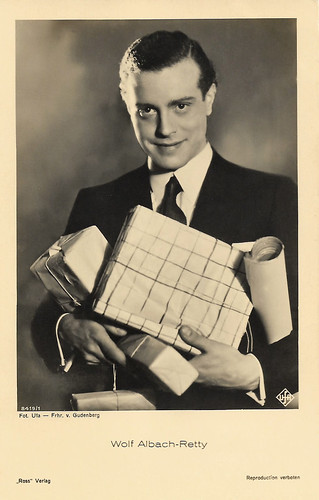
German postcard by Ross Verlag, no. 8419/1, 1933-1934. Photo: Ufa / Frhr. von Gudenberg.
The Austrian-German actor
Wolf Albach-Retty (1906-1967) is nowadays best known as the father of Romy Schneider, but during the 1930s he was a popular leading man of German cinema.

German postcard by Ross Verlag, no. 8469/1, 1933-1934. Photo: Ufa / Frhr. von Gudenberg.
Willy Fritsch (1901-1973) was the immensely popular ‘Sunny Boy’ of the Ufa operettas of the 1930s and 1940s.

German postcard by Ross Verlag, no. 8611/2, 1933-1934. Photo: Freiherr von Gudenberg / Ufa.
German actress
Brigitte Helm (1908-1996) is still famous for her dual role as Maria and her double the evil Maria, the Maschinenmensch, in the silent SF classic
Metropolis (Fritz Lang, 1927). After
Metropolis she made over 30 films in which she almost always had the starring role. She easily made the transition to sound films, before she abruptly retired in 1935.

German postcard by Ross Verlag, no. 8638/1, 1933-1934. Photo: Frhr. von Gudenberg / Ufa.
Blonde Austrian actress and singer
Gretl Theimer (1911-1972) arrived in the German cinema with the sound film and had an impressive career in the 1930s.
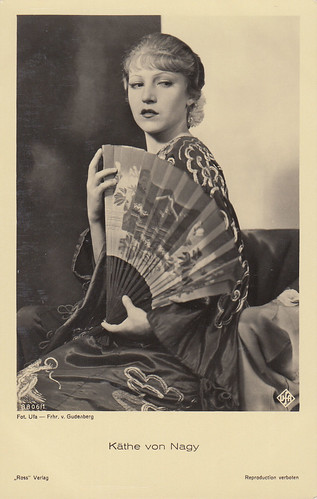
German postcard by Ross Verlag, no. 8806/1, 1933-1934. Photo: Ufa / Frhr. von Gudenberg. Collection: Marlene Pilaete.
Hungarian actress
Käthe von Nagy (1904-1973) started as the ‘Backfish’ of German films of the late 1920s. In the early 1930s, she became a fashionable and charming star of German and French cinema.

Borg Cigarette card in the Film-u. Bühnen-Lieblinge series, Serie B, Bild 86. Photo: Freiherr Wolff von Gudenberg. Collection: Marlene Pilaete.
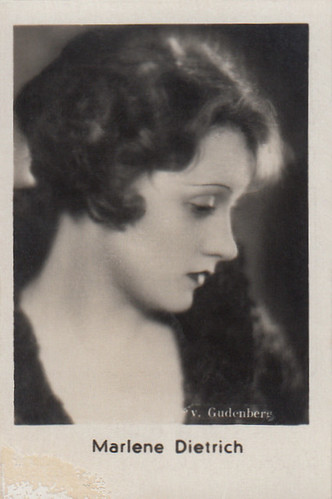
Borg Cigarette card in the Film-u. Bühnen-Lieblinge series, Serie B, Bild 112. Photo: Freiherr Wolff von Gudenberg. Collection: Marlene Pilaete.
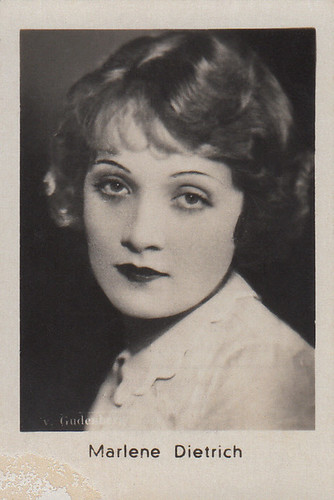
Borg Cigarette card in the Film-u. Bühnen-Lieblinge series, Serie B, Bild 89. Photo: Freiherr Wolff von Gudenberg. Collection: Marlene Pilaete.
Sources:
Un regard oblique,
ArtNet and
RKD (Dutch).







